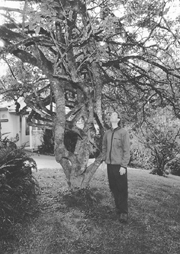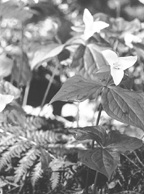

by Terry Kramer

A landscape is a natural environment designed by people, nature -- or both. The art of landscaping is to deliberately change existing natural features with the intent of making the environment more attractive.
Gardener John Nelson, groundskeeper for the Humboldt Area Foundation, is working toward the goal of joining native with non-native plants using minimal pruning to create a natural look. He is attempting to civilize nature.
"I like to make the grounds something soft and friendly, not too alien," he said.

HAF's landscape is not a botanical wonder filled with flower beds screaming with color. Tucked in a clearing atop a hill above Indianola, the property is 14 acres of subtle, quiet plants like fawn lilies, trillium, bleeding heart and deer fern. You will find thickets of overgrown Western azalea more than 50 years old, and a redwood floor carpeted with rich red duff and oxalis.
Clematis vines cling to a deck on the south side of a house that is now the foundation's office. An elevated pond constructed of flagstone is thick with water lilies and goldfish. Kenilworth ivy, an invasive non-native in some gardens, clings to crevices in the pond's structure. Towering second-growth redwoods surround the landscape.
Since inheriting stewardship of the overgrown, neglected grounds three years ago, Nelson has carved out sloping lawn areas, transforming them into natural meadows. He has created islands of shrubs and trees, including native and non-native plants.
At the entrance to the parcel, one will find the juxtaposition of Nandina, Ceanothus, Rubus calycinoides, Japanese maple, blue-eyed grass, Camassia and deer fern. All beds are smothered with a thick mulch of redwood needles.
"A lot of people don't like Nandina, but it works here," Nelson said. "Another thing that kind of surprised people when we first put this bed in, we grabbed leaves from all over the property and covered all of this.
"It's kind of an extension of the forest which is pretty wild," he said.
Since the budget for maintaining the house and grounds at HAF is limited -- $1,000 a year for everything, according to Nelson -- there is little time for tending the grounds. He said he cannot spare more than eight hours a week.
Choosing plants that require a minimum amount of maintenance is a priority. And meticulous pruning does not top the list either. A treasure of the landscape is a 50-year-old California buckeye situated in an island near the parking lot. The contorted, twisted trunk is topped by a massive canopy of green, palm-shaped leaves. Nelson marvels at its natural, untamed beauty.
"I've never pruned it. It is perfect the way it is. Why touch it?" he laughed.
The landscape started out more than 40 years ago when Lynn and Vera Vietor, both dedicated nature lovers, built a home with the land surrounding it to be preserved as a wildlife refuge. It was intended to feed and house deer, squirrels and birds.
The Vietors planted an orchard, not for themselves, but to provide apples for deer and raccoons and cherries for the birds. Vera planted natives like the western azalea, vine maple and huckleberry. These plants have been largely left untouched by Nelson.
"So many times things are better left alone. They do best without anyone touching them," he said.
Today the house is HAF's headquarters and the landscape is not solely intended to feed critters. Deer are a problem at times, said Nelson. "They are another aspect to worry about, unless the plants are right up next to the house. And the native plants seem to withstand their nibbling."
Nelson likes to experiment with non-natives that the deer won't nibble on. One successful plant is Dianella tasmanica, a fibrous-rooted member of the lily family.
"They are deer-proof and they get this really awesome blueberry, metallic blue," he said.
While Nelson likes to tinker with a few non-native plants, he ultimately wants to include more natives.
"It is all just an experiment. It really is. But I think that the native thing is really an intelligent way to go. More and more I want to go in that direction because it is just a lot less work ultimately, and it is what fits around here," he said.
There is a half-mile nature trail available to the public at HAF. A detailed brochure can guide you through a walk in the natural redwood landscape.
Terry Kramer is a Bayside free-lance writer and owner of Jacoby Creek Nursery.